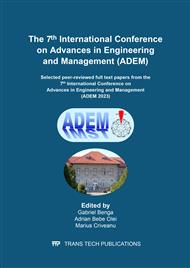p.3
p.9
p.21
p.41
p.51
p.57
p.67
p.75
Advances in Welding Techniques for Inland Waterway Shipbuilding
Abstract:
Inland waterway shipbuilding plays a pivotal role in facilitating the transportation of goods and passengers in numerous regions worldwide. To meet the ever-evolving demands of efficiency, safety, and sustainability, shipbuilders constantly seek to enhance the quality and performance of their vessels. Welding, a critical component of shipbuilding, has garnered significant attention due to its potential to introduce deformations and residual stresses, which can adversely affect structural integrity and long-term performance. This study presents preliminary research aimed at comprehensively understanding the influence of deformations and residual stresses after the welding process in inland waterway shipbuilding. The preliminary findings of this research highlight the significant influence of welding parameters, material properties, and welding sequences on the magnitude and distribution of deformations and residual stresses in inland waterway shipbuilding. These findings have implications for ship design, fabrication, and inspection procedures. By mitigating deformation and residual stress-related issues, shipbuilders can enhance the structural integrity, safety, and operational efficiency of their vessels.
Info:
Periodical:
Pages:
3-8
Citation:
Online since:
May 2025
Authors:
Keywords:
Price:
Сopyright:
© 2025 Trans Tech Publications Ltd. All Rights Reserved
Share:
Citation:


